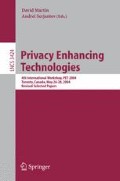Abstract
The protection goal anonymity helps to preserve the privacy of us ers by ensuring that their identity remains unknown. Many mechanisms ena bling anonymity exist. However, these mechanisms work inefficiently when used in mobile wireless networks. This contribution shows how anonymity can be provided efficiently for mobile users by exploiting the fact that they are mobile. A possible realization, called FLASCHE, is described.
Part of this work was done while the author was at the University of Freiburg
Access this chapter
Tax calculation will be finalised at checkout
Purchases are for personal use only
Preview
Unable to display preview. Download preview PDF.
References
Jendricke, U., Markotten, D.G.t.: Usability meets Security - The Identity- Manager as your Personal Security Assistant for the Internet. In: Proceedings of the 16th Annual Computer Security Applications Conference, pp. 344–353 (December 2000)
Common Criteria for Information Technology Security Evaluation. Part 2: Security Func tional Requirements. Version 2.1 (August 1999)
Rannenberg, K., Pfitzmann, A., Müller, G.: Sicherheit, insbesondere mehrseitige IT-Sicherheit. In: Müller, G., Pfitzmann, A. (eds.) Komponenten, Integration, Mehrseitige Sicherheit in der Kommunikationstechnik, vol. 1, pp. 21–29. Addison Wesley Bonn, Reading (1997)
Rannenberg, K.: Zertifizierung mehrseitiger IT-Sicherheit: Kriterien und organisatorische Rahmenbedingungen. Vieweg Wiesbaden (1998)
Clarke, R.: Identified, Anonymous and Pseudonymous Transactions: The Spectrum of Choice. In: Proceedings of the User Identification & Privacy Protection Conference, September 1999 (1999), http://www.ana.edu.au/people/Roger.Clarke/DV/UIPP99.html (accessed on March 1, 2002)
Pfitzmann, A., Köhntopp, M.: Anonymity, Unobservability, and Pseudonymity A Proposal for Terminology. In: Federrath, H. (ed.) Designing Privacy Enhancing Technologies. LNCS, vol. 2009, pp. 1–9. Springer, Heidelberg (2001)
Shmatikov, V., Hughes, D.: Defining Anonymity and Privacy(extended abstract). In: Workshop on Issues in the Theory of Security (WITS 2002) (2002)
Samarati, P., Sweeney, L.: Protecting Privacy when Disclosing Information: k-Anonymity and its Enforcement through Generalization and Suppression. Technical Report SRI-CSL-98, Computer Science Laboratory, SRI (1998)
Chaum, D.: The dining cryptographers problem: unconditional sender and recipient un-traceability. Journal of Cryptology 1(1), 65–75 (1988)
Waidner, M., Pfitzmann, B.: Unconditional Sender and Recipient Untraceability in spite of Active Attacks - Some Remarks. In: Fakultät für Informatik, Universität Karlsruhe, Interner Bericht 5/89 (March 1989), http://www.semper.org/sirene/publ/WaPf_89IB_DCandFailStop.ps.gz (accessed on May 24, 2002)
Martin, D.: Local Anonymtiy in the Internet. Ph. D. Thesis, Boston University of Computer Science (1999)
Borning, M., Kesdogan, D., Spaniol, O.: Anonymität und Unbeobachtbarkeit im Internet (Anonymity and Untraceability in the Internet). it+ti Informationstechnik und Technische Informatik 5(43), 246–253 (2001)
Chaum, D.: Untraceable Electronic Mail, Return Addresses, and Digital Pseudonyms. Communications of the ACM 2(24), 84–88 (1981)
Goldschlag, D.M., Reed, M.G., Syverson, P.F.: Hiding Routing Information. In: Anderson, R. (ed.) IH 1996. LNCS, vol. 1174, pp. 137–150. Springer, Heidelberg (1996)
Kesdogan, D., Egner, J., Büschkes, R.: Stop-and-Go-MIXes Providing Probabilistic Anonymity in an Open System. In: Aucsmith, D. (ed.) IH 1998. LNCS, vol. 1525, pp. 83–98. Springer, Heidelberg (1998)
Berthold, O., Federrath, H., Köpsell, S.: Web MIXes: A System for Anonymous and Unobservable Internet Access. In: Federrath, H. (ed.) Designing Privacy Enhancing Technologies. LNCS, vol. 2009, pp. 115–129. Springer, Heidelberg (2001)
Danezis, G., Dingledine, R., Mathewson, N.: Mixminion: Design of a Type III Anonymous Remailer Protocol. In: IEEE Security and Privacy Symposium (2003)
Reiter, M., Rubin, A.: Crowds: Anonymity for Web Transactions. ACM Transactions on Information and Systems Security 1(1), 66–92 (1998)
Foreman, G.H., Zahorjan, J.: The Challenges of Mobile Computing. IEEE Computer 6(27) (1994)
Narten, T., Draves, R.: Privacy Extensions for Stateless Autoconfiguration in IPv6 (January 2001), http://www.ietf.org/rfc/rfc3041.txt (accessed on June 21, 2002)
Orava, P., Haverinen, H., Honkanen, J.-P., Edney, J.: Temporary MAC Addresses for Anonymity. Document 02/261 of the 802.11i working group (2002), http://grouper.ieee.org/groups/802/11/Documents/D2T251-300.html (accessed on June 6, 2003)
Zugenmaier, A.: The Freiburg Privacy Diamond - A Conceptual Model for Mobility in Anonymity Mechanisms. Proceedings of IEEE Globecom 2003 (2003)
Zugenmaier, A., Kreutzer, M., Müller, G.: The Freiburg Privacy Diamond: An Attacker Model for a Mobile Computing Environment, Kommunikation in Verteilten Systemen, KIVS 2003, Leipzig (2003)
Department of Defense MIL-STD-2401. World Geodetic System WGS84, http://164.214.2.59/publications/specs/printed/WGS84/wgs84.html (accessed on March 7, 2002)
Krengel, U.: Einführung in die Wahrscheinlichkeitstheorie und Statistik, 4th edn. Vieweg Braunschweig/Wiesbaden (1998)
Wiese, H.: Das neue Internetprotokoll IPv6. Hanser Verlag München (2002)
Narten, T., Draves, R.: Privacy Extensions for Stateless Autoconfiguration in IPv6 (January 2001), http://www.ietf.org/rfc/rfc3041.txt (accessed on June 21, 2002)
Anderson, R.: Security Engineering: A Guide to Building Dependable Systems. Wiley, Chichester (2001)
Bellovin, S.: Defending Against Sequence Number Attacks (May 1996), http://www.ietf.org/rfc/rfc1948.txt (accessed on July 30, 2002)
Fielding, R., Gettys, J., Mogul, J., Frystyk, H., Masinter, L., Leach, P., Berners-Lee, T.: Hypertext Transfer Protocol – HTTP/1.1 (June 1999), http://www.ietf.org/rfc/rfc2616.txt (accessed on May 21, 2002)
Khare, R., Lawrence, S.: Upgrading to TLS Within HTTP/1.1 (May 2000), http://www.ietf.org/rfc/rfc2817.txt (accessed on May 21, 2002)
Jendricke, U.: Der Identitätsmanager. Doctoral Thesis, Rhombos Verlag (2002)
Stevens, R.: Programmierung von UNIX-Netzwerken, 2nd edn. Hanser (2000)
Author information
Authors and Affiliations
Editor information
Editors and Affiliations
Rights and permissions
Copyright information
© 2005 Springer-Verlag Berlin Heidelberg
About this paper
Cite this paper
Zugenmaier, A. (2005). FLASCHE – A Mechanism Providing Anonymity for Mobile Users. In: Martin, D., Serjantov, A. (eds) Privacy Enhancing Technologies. PET 2004. Lecture Notes in Computer Science, vol 3424. Springer, Berlin, Heidelberg. https://doi.org/10.1007/11423409_9
Download citation
DOI: https://doi.org/10.1007/11423409_9
Publisher Name: Springer, Berlin, Heidelberg
Print ISBN: 978-3-540-26203-9
Online ISBN: 978-3-540-31960-3
eBook Packages: Computer ScienceComputer Science (R0)

